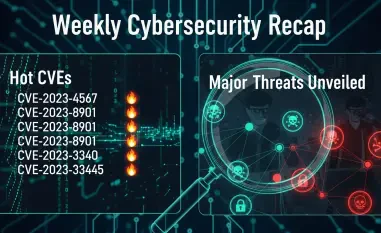The Experian’s 12th Annual Data Breach Industry Forecast presents a comprehensive analysis of potential cybersecurity trends and threats for 2025. This forward-looking report highlights the evolving landscape of cybercrime, increasingly driven by advancements in AI and the rising involvement of younger individuals and tech-savvy insiders. As businesses and consumers face an era marked by sophisticated cyber threats, understanding the dynamics at play will be paramount. With the cybercrime ecosystem becoming more complex and varied, it is imperative to stay ahead of these developments to protect sensitive information and ensure the integrity of digital operations.
The Rise of Teen Cybercriminals
One of the key themes forecasted for 2025 is the increasing involvement of teenagers in cybercrimes. FBI data reveals a striking trend where the average age of individuals arrested for cybercrime stands at 19, significantly younger compared to the broader crime arrest average age of 37. This notable involvement of teens is attributed to their recruitment by more seasoned fraudsters who exploit popular platforms like online gaming, chatrooms, and social media for their reach. These platforms provide an avenue for fraudsters to tap into the youthful demographic, leveraging their technical skills and familiarity with digital environments to perpetrate different forms of cybercrime.
Legislation and law enforcement focus on combating revenge porn, cyberbullying, and online fraud are expected to lead to a notable increase in teen prosecutions related to cybercrimes. The accessibility of technology and the anonymity provided by the internet make it easier for teenagers to engage in these activities without fully understanding the consequences. As law enforcement catches up with these evolving cybercriminal tactics, an uptick in teen-related cybercrime cases is anticipated. This growing trend underscores the importance of educating young individuals about the legal and ethical implications of their online actions to curb their involvement in criminal activities.
Internal Threats from AI-Savvy Employees
Another major trend anticipated is the rise in internal fraud facilitated by employees trained in advanced AI techniques. With corporations investing heavily in AI education for their workforce, there lies an increased risk of misuse by insiders. This insider threat could result in the theft of sensitive information and other forms of internal fraud. The advanced understanding of AI technologies among employees could inadvertently create opportunities for exploitation, compromising corporate data security from within. Organizations must be aware of these potential risks and develop stringent monitoring systems to counteract any internal threats posed by their employees’ AI acumen.
A significant data breach caused by an AI-trained insider within a global brand is forecasted to occur, showcasing the potential hazards of internal threats fueled by advanced technological training. Companies must be vigilant and implement robust monitoring systems to detect and prevent such internal threats. This includes regular audits, employee training on ethical AI use, and the creation of a transparent reporting system for suspicious activities. By taking proactive measures, organizations can minimize the risks associated with insider threats and safeguard their operations against potential data breaches carried out by their own employees.
Power-Hungry Data Centers as Targets
Power-hungry data centers are identified as emerging targets for cyberattacks. Generative AI technologies like ChatGPT require substantial amounts of power to operate, making data centers that house these technologies appealing targets for cybercriminals. These systems, consuming significantly higher electricity per query compared to conventional searches, present new vulnerabilities. The dependence on high power consumption makes these data centers susceptible to targeted attacks that aim to disrupt their energy supply, thereby crippling the infrastructure that supports key AI operations. As cybercriminals become more sophisticated, the vulnerabilities of power-dependent data centers become an attractive target in their exploitation strategies.
Disparities in cloud infrastructure security across various countries exacerbate this problem, raising the likelihood of successful cyberattacks on a national scale. Such attacks could potentially disrupt entire nations’ cloud infrastructures by targeting their power resources, leading to widespread consequences. The uneven security measures in place across different regions provide openings for attackers to penetrate weaker systems, causing significant disruption. Addressing these disparities and reinforcing security protocols across global data centers is critical to maintaining resilience against targeted cyberattacks that exploit power resource vulnerabilities.
Hacker-on-Hacker Conflicts
The theme of “predator becomes prey” is highlighted by incidents of hackers falling victim to more sophisticated malware deployed by other hackers. This trend illustrates a growing complexity within the cybercrime landscape, where cybercriminals themselves face attacks from rival factions for political or financial gain. As competition among cybercriminals intensifies, these internal conflicts are becoming increasingly common, leading to a new layer of unpredictability in the cybersecurity environment. The ongoing battle between hacker groups serves to highlight the ever-evolving nature of cyber threats and the necessity for organizations to stay ahead of these continuous advancements.
This emerging dynamic signifies a shift in which traditional boundaries between predators and prey among hackers are increasingly blurred. The rise in hacker-on-hacker conflicts could lead to more sophisticated and unpredictable cyber threats, complicating the cybersecurity landscape further. Each incident of inter-hacker rivalry not only escalates the level of cybercrime but also introduces unforeseen threats that could spill over to impact innocent stakeholders. Moreover, organizations must remain prepared for potential blowback as these hacker conflicts may lead to collateral damage affecting corporate and public systems.
Dynamic Identification for Fraud Prevention
In response to the sophistication of AI-driven fraud, the forecast predicts a shift towards dynamic identification as a defense mechanism against fraud. Traditional forms of identification like static driver’s licenses and social security cards are becoming inadequate in the face of advanced fraudulent techniques that can create indiscernible proof-of-life documents. Fraudsters leveraging AI technologies are capable of crafting highly convincing fake identities, making static identification methods vulnerable and ineffective. This underscores the urgent need for more adaptive and dynamic strategies to counteract these evolving threats.
Governments and agencies are anticipated to adopt dynamic identification methods, which continuously change, akin to a 3D barcode used for event tickets, to stay ahead of the evolving fraud landscape. This shift will require significant investment and innovation in identification technologies to effectively combat AI-driven fraud. By deploying more secure and adaptable identification systems, authorities aim to outpace fraudsters’ advancements and protect sensitive personal and financial data. The move towards dynamic identification reflects a broader strategic pivot necessary to contend with the escalating sophistication of cyber fraud techniques.
The Dual-Edged Nature of AI in Cybersecurity
The Experian’s 12th Annual Data Breach Industry Forecast provides an in-depth analysis of expected cybersecurity trends and threats for 2025. This insightful report sheds light on the ever-changing cybercrime landscape, now increasingly influenced by advances in artificial intelligence and the growing participation of younger, tech-savvy hackers and insiders. In a time when businesses and consumers are confronting highly sophisticated cyber threats, comprehending these dynamics will be crucial. The ecosystem of cybercrime is becoming more intricate and diverse, making it essential to stay ahead of these developments to safeguard sensitive data and maintain the integrity of digital operations. This forecast urges vigilance and proactive measures, emphasizing that anticipation and early response are key to defending against the evolving threats. As digital environments continue to advance, so do the tactics and technologies used by cybercriminals. Hence, continuous education, robust security frameworks, and adaptive strategies are vital for mitigating risks and shielding against potential breaches.













